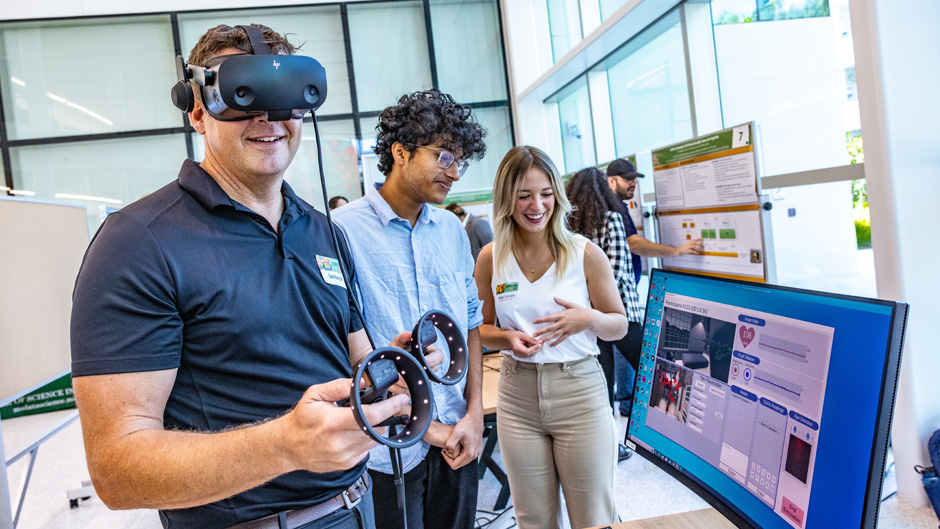There were ideas about how to create an entire hospital powered by artificial intelligence. A virtual reality experience to help patients with severe phobias rid themselves of anxiety from spiders and dogs, and career advice for students about to enter the technology field.
Participants of the University of Miami’s first Computing Day learned about these topics and more at the new Frost Institute for Chemistry and Molecular Science building on April 14. Hosted by the Office of the Provost in collaboration with the Institute for Data Science and Computing, and the departments of Interactive Media, Computer Science, and Electrical and Computer Engineering, the event brought together students, faculty and staff members, and alumni from medicine, computer science, interactive media, engineering, and other disciplines who are using technology to push the boundaries of their expertise. Some high school students, along with visitors from other universities, also attended.
“Today we’ll not only hear from distinguished speakers, but also from all of you who will become the distinguished speakers and leaders of this field,” said Jeffrey Duerk, the University’s executive vice president for academic affairs and provost. “When you graduate, the first thing I want you to think about is how you’ll lead your field because of what you acquired here at the University of Miami. If not for events like this, we would not be preparing you completely for that future.”
Computing Day began with keynote speaker Pierre Baldi, a distinguished professor of computer science at the University of California, Irvine (UCI), talking about the possibilities he sees for today’s technology. Baldi explained his vision for AI-powered health care at a time when he thinks it is needed because patient caseloads are outpacing the number of doctors and nurses entering the workforce.
“What do I mean by an AI-driven hospital of the future?” asked Baldi, who specializes in the application of AI and machine learning to natural sciences. “It is a hospital where humans and AI work together side by side. AI will not replace humans, but AI can penetrate every process in the hospital from surgery, diagnostic, imaging, billing, and electronic medical records. It will provide more precise, efficient, and cost-effective health care for all.”
As an example, Baldi highlighted a program created by his students that uses computer vision AI to detect polyps in the colon of patients during a colonoscopy procedure. To build the program, the students used computer vision to analyze the photos of 7,000 colonoscopies performed at UCI’s Medical Center. It was quickly able to detect polyps within 20 milliseconds, helping physicians not to miss them during the procedures.
“In the future, we want to create a capsule you can swallow to go through your digestive system and your colon and remove polyps,” Baldi added.
Another application looked at using mammograms to predict cardiovascular conditions in women. Another uses lung X-rays of dogs to help veterinarians identify valley fever, a disease which is extremely contagious for the canine population in the Southwestern United States.
But Baldi also recognizes the perils of artificial intelligence. He mentioned one of the most intriguing applications unveiled recently, called large language models, or LLMs. These are the algorithms used to power the popular text generator called ChatGPT, which are trained using all the text available on the internet and in books. Baldi said he is impressed with the knowledge and abilities of ChatGPT-3. Yet, he thinks the nation needs to tread cautiously.
“Right now, there are just four or five LLMs, but let’s suppose we have 1,000 or 1 million of them interacting, maybe cooperating or maybe competing,” he said. “No one has the faintest idea of what happens under those scenarios. It’s not very difficult to make these. But we don’t know how they work exactly, and we cannot predict their behavior. For example, these could create 10 million free workers and inject them into the economy in the future. But it’s not clear what happens to the economy.”
He suggested that the U.S. government require all the LLM creators to register their versions, so that at least there is knowledge of how many exist, and to prevent what he called nefarious uses.
During the rest of Computing Day, students and faculty members presented projects from throughout the University during a poster session. Rajvi Shah, a senior studying geography and sustainable development, as well as graduate student Luis Angeles, gave demonstrations of a virtual reality application they are working on to introduce potential doctors to the Miami-Dade County region by taking them on a virtual tour with interactive maps. Titled (305) 360 degrees, the application, which is sponsored by Sylvester Comprehensive Cancer Center, offers interactive data about demographics, lifestyle, and health in Miami-Dade County.
“It’s a very creative project and does get me out of my typical data science work,” said Shah, who is focusing her efforts on geospatial technology. “I am new to VR, but it’s been very interesting to conceptualize this project.”
An afternoon panel showcased five alumni working in the computing industry at companies including Spotify, ContentSquare, Booking.com, Access Physicians, and the NBA.
Kelsey Kjeldsen, now a senior technical project manager for video at the NBA, left the University in 2016 with a master’s degree in game and interactive media design. But upon graduation, Kjeldsen said she struggled to find a full-time job and was forced to accept an internship with a local web developer. Because the company was small, she learned how to adapt software for both Apple and Android phones, in addition to computers, and said the experience really helped broaden her abilities. She offered this advice to soon-to-be graduates: “Keep your head down, keep working, and expose yourself to as many opportunities as possible. Do an online bootcamp and continue to advance in your industry, because the technology you know now will not be relevant in 10 years.”

